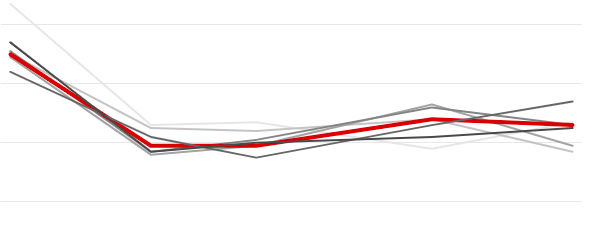Western Australia is the last place in Australia where the voting system strongly pushes voters into casting a vote which hands total control of preferences over to the party who receives that vote, by imposing voting rules that make it difficult to break out.
Prior to the 2016 Senate reforms, voters who wished to opt out of the group voting ticket system needed to number almost every box below the line, which peaked at 110 candidates for the New South Wales Senate contest in 2013. I blogged about how the size of the candidate list (and thus the difficulty in casting a formal below-the-line vote) correlated with the informal rate, and with the proportion of voters who actually cast a formal below-the-line vote.
The 2016 reforms both made it easier to vote below-the-line (just number six boxes) but also changed above-the-line voting so it became a more convenient way for voters to mark their own preferences for whole groups of candidates, instead of a method of surrendering control to a party.
This just leaves Western Australia and Victoria using above-the-line voting, but below-the-line voting is much easier in Victoria, where you just need to number five boxes. A concerted effort to encourage below-the-line voting in Victoria saw the proportion of formal votes cast below the line increase from 6.1% in 2014 to 8.8% in 2018.
The rules for voting below the line in Western Australia are much stricter than in Victoria, which has generally led to a lower rate of below-the-line voting. This chart shows the trend for the state (in red) and each of the regions, which are all very similar.
It’s worth noting that I call it “below-the-line” voting but until 2017 the Western Australian upper house ballot paper was vertical, so these were really “right-of-the-line” votes.
There was a significant drop-off in below-the-line voting after 2001. There was a slight increase in the number of candidates between 2001 and 2005, but nothing compared to the nominations at the 2017 and 2021 elections.
The rate rose to a new peak in 2013, and then declined slightly in 2017.
Up until 2008, the rural regions tended to produce the higher rates of below-the-line voting, but since 2013 urban regions have tended to top the list.
So are you going to consider voting below-the-line?
Right or wrong, the rules do make it hard. So don’t try and do it unless you plan to do it properly and number every box. Also remember that you can vote both above and below the line. If your below vote is informal, the above will count and your vote will not be informalised. I’d also recommend checking out Antony Green’s blog post on this topic with some frequently asked questions. Good luck!




There is an outside chance that this will be the last GTV election, if both WA and Victoria replace the system before the next election. I suspect that WA is more likely to do so than Victoria.
Comments are closed.